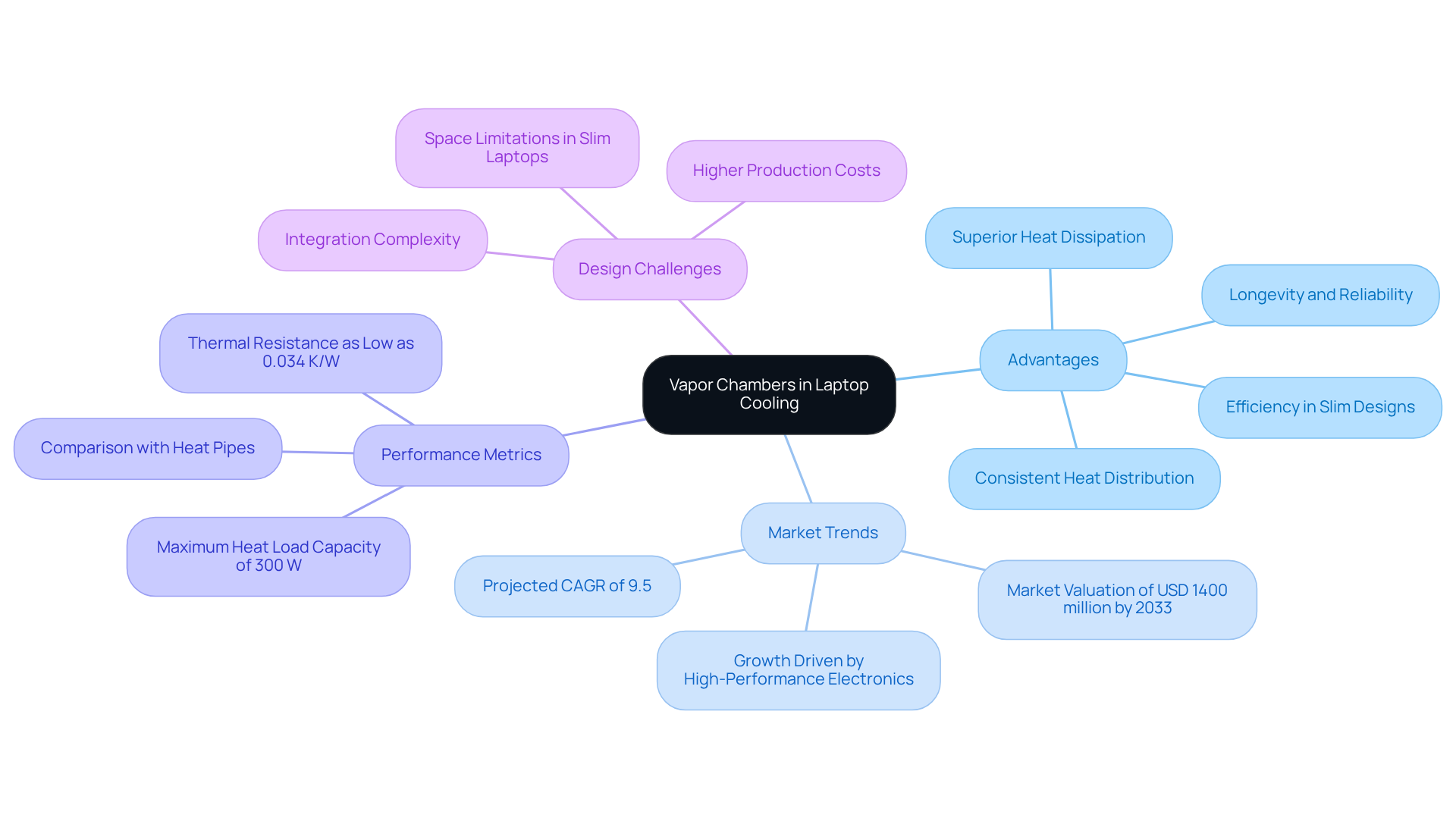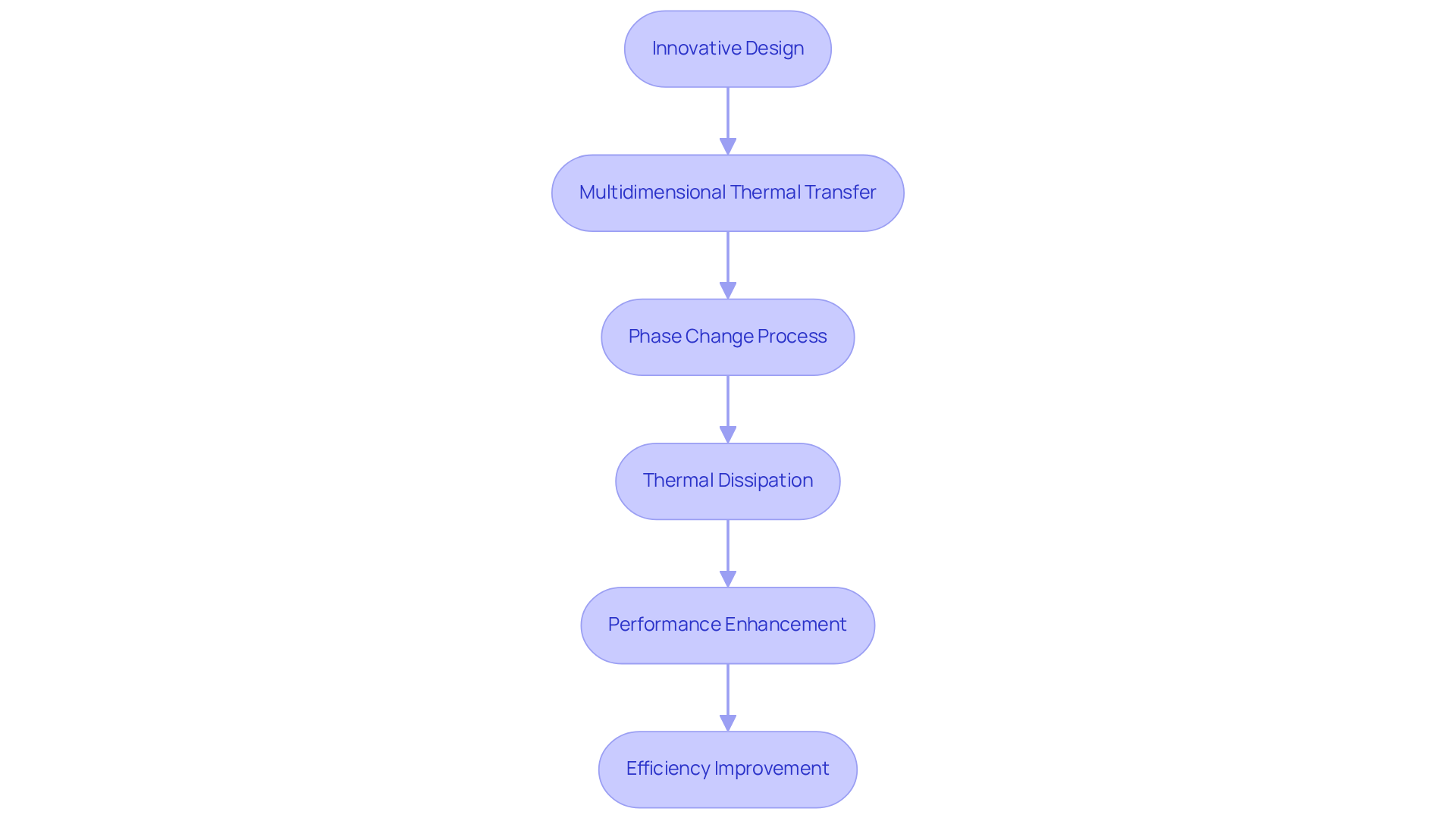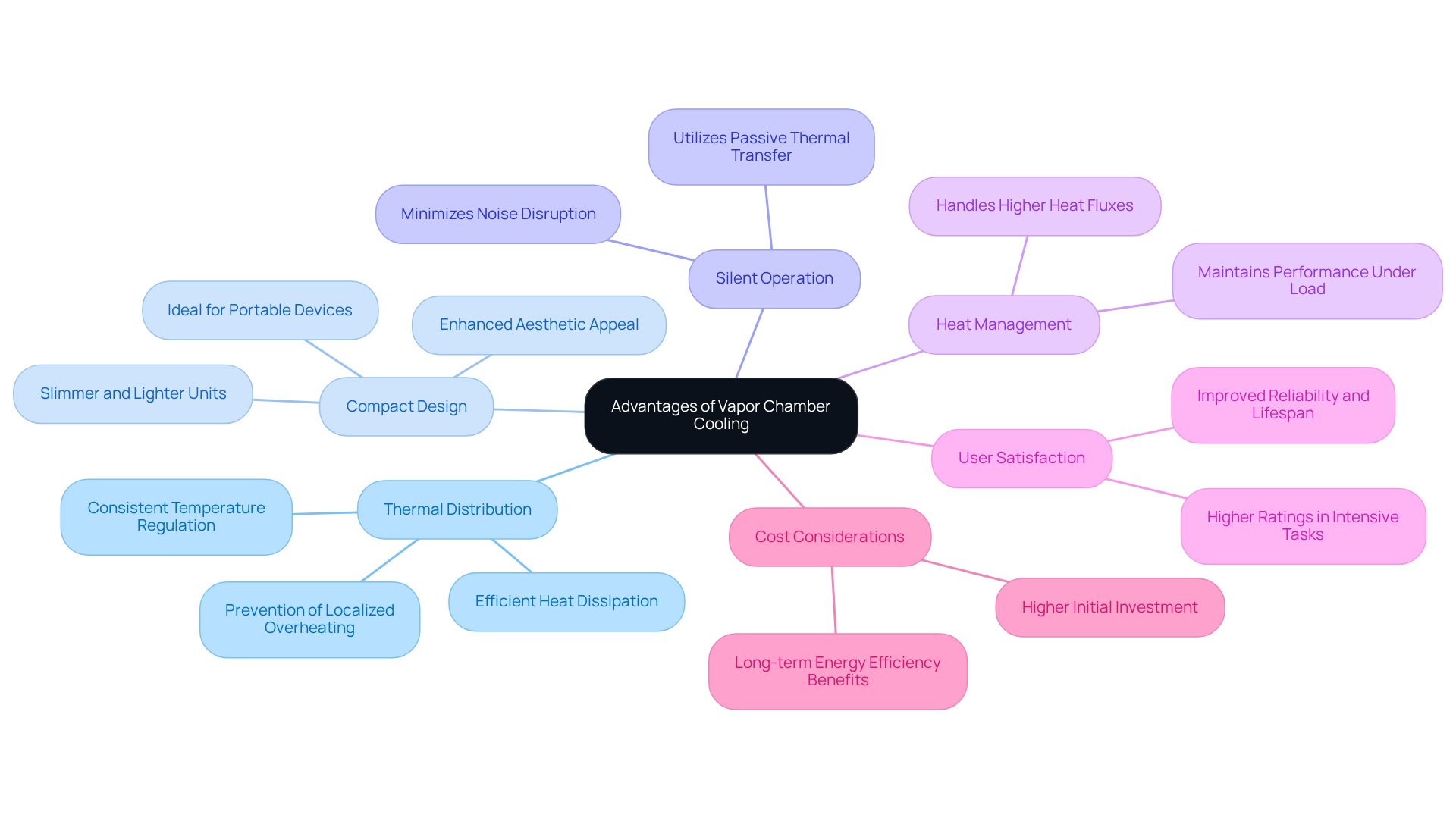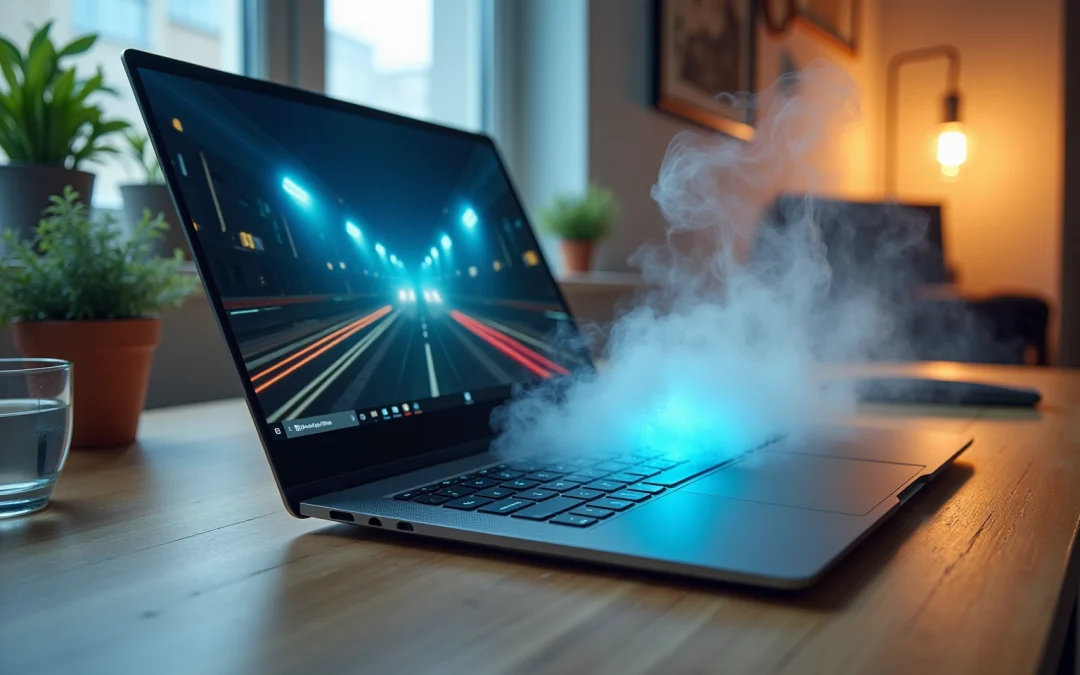Overview
Vapor chamber technology for laptop cooling represents a significant advancement in thermal management solutions. This innovation employs a sealed enclosure filled with liquid that evaporates and condenses, effectively dissipating heat from high-performance components such as CPUs and GPUs. This method not only provides superior thermal distribution but also enhances efficiency compared to traditional cooling systems.
As modern laptops increasingly demand effective temperature management to prevent overheating during intensive tasks, the adoption of vapor chamber technology becomes essential. By integrating this technology, manufacturers can ensure optimal performance and longevity of high-performance devices.
Introduction
Vapor chamber technology is revolutionizing the way laptops manage heat, addressing the growing demands of high-performance computing. This innovative solution employs advanced thermal management techniques that leverage phase change principles, promising to enhance cooling efficiency and maintain optimal device performance. However, as laptops become increasingly powerful and compact, a significant challenge remains: how can manufacturers effectively integrate these sophisticated cooling systems without inflating production costs?
Define Vapor Chamber Technology
Vapor technology represents a cutting-edge thermal management solution that leverages phase change principles to effectively dissipate heat from electronic components. A steam enclosure consists of a sealed vessel containing a small amount of liquid, typically water. Upon heating, this liquid evaporates, transforming into gas that migrates to cooler regions of the enclosure, where it condenses back into liquid, facilitating energy transfer away from critical components such as CPUs and GPUs.
This method proves particularly advantageous in high-performance environments like a vapor chamber laptop, where effective temperature management is crucial for maintaining performance and preventing overheating. Notably, fluid-filled units as thin as 0.4 mm are currently utilized in 85% of high-end smartphones launched in 2024, underscoring their growing relevance in modern electronics.
Additionally, the integration of vapor chamber laptops in AI-driven and edge computing devices has surged by 38% over the past two years, emphasizing their role in managing substantial thermal outputs within compact designs. Furthermore, advanced pump technologies, including solenoid and rotary boost pumps, are essential for precision applications in electronic temperature regulation. These pumps operate at pressures reaching 16 Bar while maintaining low noise levels, thereby enhancing the efficiency of thermal management systems.
Gagner-Toomey Associates stands at the forefront of providing innovative temperature regulation solutions, incorporating these advanced pumping systems to significantly improve thermal dissipation efficiency in electronic devices.

Contextualize Vapor Chambers in Laptop Cooling
Vapor chamber laptops have emerged as a vital solution to address the rising thermal needs of contemporary laptops, which are progressively outfitted with high-performance processors and graphics cards. Conventional temperature control techniques, primarily relying on thermal conduits and fans, often lead to inconsistent warmth distribution and thermal throttling, undermining performance. In contrast, heat management technology represents a significant advancement, enabling consistent heat distribution over a larger surface area. This is particularly advantageous for slender and lightweight laptop designs, where space limitations necessitate efficient temperature management.
As laptops evolve to accommodate more powerful components, cooling systems have become the preferred choice for manufacturers aiming to enhance thermal management. However, the integration of liquid compartments in laptops results in increased production costs compared to traditional temperature regulation methods, a critical consideration for producers.
Case studies indicate that gas enclosures can achieve thermal resistance as low as 0.034 K/W, with a maximum heat load capacity of 300 W, thereby significantly improving heat dissipation efficiency. Furthermore, the market for thermal management devices is projected to expand at a CAGR of 9.5%, with an anticipated valuation of approximately USD 1400 million by 2033. This growth underscores the increasing demand for sophisticated thermal solutions in high-performance electronics.
Such expansion highlights the essential role of thermal devices, especially the vapor chamber laptop, in the future of laptop temperature management technologies, particularly in high-performance laptops designed for gaming, video editing, or 3D rendering. Nevertheless, the incorporation of thermal management systems into slim and portable laptops poses challenges due to space constraints that engineers must consider in their designs.

Explain How Vapor Chambers Improve Cooling Efficiency
Vapor units significantly enhance cooling efficiency through their innovative design and operational principles. Unlike conventional thermal pipes, which primarily transfer warmth in a linear fashion, fluid-filled containers distribute thermal energy across two dimensions, effectively utilizing their entire surface area. This multidirectional thermal transfer facilitates the rapid movement of warmth from hot spots to cooler regions, thereby minimizing temperature gradients within the device.
The operational mechanism hinges on a phase change process, wherein the working liquid evaporates and subsequently condenses, allowing for swift thermal transfer as gas traverses the space. Furthermore, the expansive surface area of cooling units contributes to improved thermal dissipation, reducing the risk of overheating and ensuring optimal performance during demanding tasks. This capability is particularly crucial in gaming laptops and high-performance workstations, especially in a vapor chamber laptop, where sustained performance is essential.
As Whitson Gordon astutely notes, “And when a device requires advanced temperature regulation and performance, we rely on specialized enclosures to elevate it — so you never miss a frame.”
Research indicates that containment systems can enhance efficiency by 20-30% compared to traditional thermal pipes, underscoring their importance in modern electronics. Additionally, a comparative study revealed a thermal resistance of 0.05 K/W at 420 W, further validating the performance metrics associated with vapor systems.

Highlight Advantages Over Traditional Cooling Methods
Vapor devices present distinct advantages over traditional methods like pipe systems and fans. The exceptional thermal distribution capabilities of a vapor chamber laptop ensure consistent temperature regulation across its surface, effectively preventing localized overheating that could compromise component integrity and performance. Notably, the design of vapor chamber laptops incorporates heat exchange units that are slimmer and lighter than conventional thermal management solutions, making them particularly suitable for sleek laptop designs. This compactness not only boosts portability but also enhances aesthetic appeal.
Additionally, thermal systems operate silently, utilizing passive thermal transfer techniques that minimize noise, unlike active cooling methods that may disrupt user experience. They excel at managing higher heat fluxes, which is vital for high-performance applications requiring rapid heat dissipation. The advancement of thermal control in laptops, particularly with the use of vapor chamber laptop technology, significantly improves both device performance and user satisfaction.
Real-world examples demonstrate that laptops equipped with liquid temperature regulation systems consistently achieve higher user satisfaction ratings, particularly in demanding scenarios such as gaming or intensive computational tasks. Expert insights further emphasize that thermal pads are crucial in the design of modern, slim laptops, providing effective thermal management without sacrificing performance.
However, it is important to consider the potentially higher costs associated with vapor chamber laptops compared to traditional cooling solutions, alongside their environmental benefits, including reduced energy consumption and enhanced energy efficiency.

Conclusion
Vapor chamber technology signifies a remarkable leap forward in laptop cooling solutions, leveraging the principles of phase change to adeptly manage heat dissipation. By employing a sealed enclosure filled with liquid, this groundbreaking approach guarantees efficient thermal regulation, which is essential for high-performance laptops outfitted with robust processors and graphics cards. The capacity to sustain a consistent temperature across a device’s surface not only boosts performance but also mitigates overheating, establishing vapor chambers as a vital element in contemporary laptop design.
The discussion has illuminated the numerous advantages of vapor chambers over conventional cooling methods. These benefits encompass:
- Superior thermal distribution
- Diminished noise levels
- Heightened efficiency, especially in compact designs where space is limited
Case studies and research reveal that vapor chambers can attain significantly lower thermal resistance, enabling laptops to manage elevated heat loads without sacrificing performance. The increasing market demand for advanced thermal management solutions further accentuates the significance of these technologies in the advancement of electronic devices.
As laptops persist in pushing the limits of performance, the incorporation of vapor chamber technology will be instrumental in ensuring optimal operation under strenuous conditions. Adopting this state-of-the-art solution not only enhances user experience but also contributes to the longevity and reliability of high-performance laptops. For both manufacturers and consumers, investing in vapor chamber technology represents a forward-thinking decision that aligns with the future of efficient and effective thermal management in electronics.
Frequently Asked Questions
What is vapor chamber technology?
Vapor chamber technology is an advanced thermal management solution that uses phase change principles to dissipate heat from electronic components. It consists of a sealed vessel containing a small amount of liquid, usually water, which evaporates when heated and condenses in cooler areas, facilitating heat transfer away from critical components like CPUs and GPUs.
Where is vapor chamber technology commonly used?
Vapor chamber technology is particularly beneficial in high-performance environments, such as vapor chamber laptops and high-end smartphones, where effective temperature management is essential to prevent overheating and maintain performance.
How thin can vapor chamber units be?
Fluid-filled vapor chamber units can be as thin as 0.4 mm and are currently used in 85% of high-end smartphones launched in 2024.
What is the trend in the integration of vapor chamber technology in devices?
The integration of vapor chamber technology in AI-driven and edge computing devices has increased by 38% over the past two years, highlighting its importance in managing high thermal outputs in compact designs.
What role do advanced pump technologies play in vapor chamber systems?
Advanced pump technologies, such as solenoid and rotary boost pumps, are crucial for precision applications in electronic temperature regulation. These pumps can operate at pressures up to 16 Bar while maintaining low noise levels, enhancing the efficiency of thermal management systems.
Who is leading in providing solutions for thermal management?
Gagner-Toomey Associates is a leading provider of innovative temperature regulation solutions, incorporating advanced pumping systems to significantly improve thermal dissipation efficiency in electronic devices.

